American Sabbatical 012: 9/12/96
Lincoln Country
9/12 (continued).. Illinois.
Peggy went for a tour of the Masters’ house and got the low down. I sat down on a wagon
tongue at New Salem Village and played with watercolor. Lincoln
ran a store, briefly, at this site, where a commercial town had
been set up on spec. No farmers here, just merchants, millers
and tradesmen. For whatever reason, Petersburg beat out New Salem
for the trade (politics, wouldn’t you guess?), and the place got
plowed under. But the foundations were still there, and the CCC
resurrected the place in the 30’s. Now a state historic site with
reenactors in costume and a MacDonalds in the gift shoppe, the
ville itself still has a magic feel out of time. Well done!
| Details of note: no cap-piece on the roof ridge, one side is shingled
up over the other past the ridge and that’s that; mud and log
chimneys sitting on laid rock hearths and fireplaces, so they
weren’t entirely incendiary; split-rail fences had slanting upright
tie-pieces at every juncture, so they were even more lumber-intensive
than imagined. |
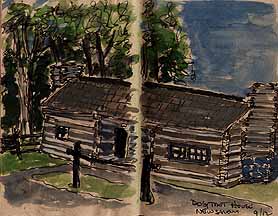
Dogtrot (Bryce)
|
One of Peggy’s quests was to find out about Lincoln’s patent.
He’s the only prez to hold one. So we asked the local historo-techie.
Turns out Lincoln ended up at New Salem because the flat boat
he was working up river got stuck on a bar there. (You might say
old Abe ran into a bar in New Salem.) This must have festered
with the tall one (maybe New Salem got to him too), because he
later designed a device for freeing stuck flat boats. Bob, our
informant at the village, told us this, and described it as a
series of air chambers and tanks. “Like a camel?” I asked, remembering
my Patrick O’Brien. “Well, we don’t have many of those here,”
was the response.
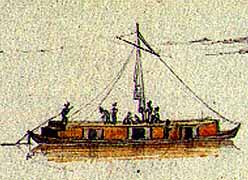
Flatboat (Bodmer sketch 1832)
|
It was a relief to be under the tall trees in a nineteenth century
town out of the highway glare. But we had horses to ride. Next
we zigged and zagged to Springfield, a horse in a different garage.
Another state capital that feels like a papershufflers paradise.
An impenetrable maze of one-way streets marching in lockstep around
faceless state institutions. In the heart of Springfield, however,
is Lincoln’s house and a reconstructed neighborhood. You can actually
get a sense of the man, the who-he before the icon, on this restored
side street. Modest and unassuming, a small-town man. No wonder
the powerful sneered. |
A model of his patent was on display, if you’re still curious.
It consisted of a set of bellows on either side of the boat which
could be inflated, expanding vertically to lift the boat, or rock
it side to side. Again we see the mad urge to verticality in this
landscape.
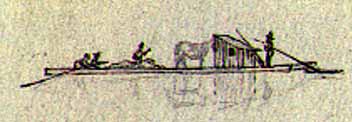
(Memo #12)
Sept. 12 B - LINCOLN - NEW SALEM AND SPRINGFIELD
Who? Abraham Lincoln
What? reconstructed frontier village where he had a store; and
only home he and Mary Lincoln ever owned
Where? New Salem, Illinois (store); Springfield, Illinois (house)
When? 1831 - New Salem, Springfield about 1840
How? first got to New Salem by flatboat. Bought house in state
capital where he was a successful lawyer-politician
Topics: Lincoln, historical reconstructions, created communities,
rivers
myths and the people behind them.
|
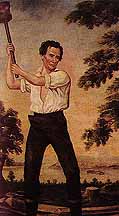
(anon. 1850s)
|
|
Questions: Who is the only US president to hold a patent? What
was it? What presidents were surveyors? What is truth and what
is myth about Abraham Lincoln and Mary Todd Lincoln? How industrial
was preindustrial society? What rivers would be accessible from
New Salem, Illinois? How do flat boats get up river? Did Petersburg
have a geographical advantage over New Salem? Was Springfield
really more “central” than Vandalia as a state capital? |
|
Visiting both New Salem and Springfield gave me a chance to go
behind the myth of Abraham and Mary Lincoln to the real man and
the real woman. New Salem is where Abraham started his independent
life as a young adult. It was also a created or consciously built
community that shows how businessmen approached the frontier,
and how some settlements failed and why. Springfield was the center
of
Lincoln’s political and legal career, his marriage, and his family
life until he left for the White House.
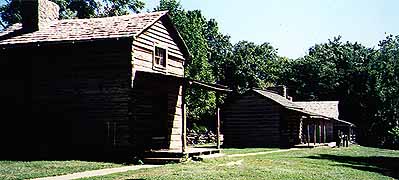
New Salem
NEW SALEM - an unsuccessful planned community, recreated.
New Salem is a reconstructed community based on photographs and
excavations. The current buildings were mostly built in the 1930’s
by a CCC group. It is two miles from Petersburg. There is an entry
and parking lot and fenced enclosure to the village area. You
walk in down a wooded lane with split rail fences alongside, small
clapboard cabins stand every hundred feet or so, smoke coming
from the chimneys, and people in period clothing walking about
at their chores. You really are transported.
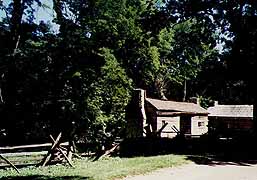
Another angle
|
The original village was created in the 1830’s by two businessmen
to be a business center. “It was really just like a strip mall!”
said one guide. The idea was to provide stores and a mill at the
head of a river system. Residents were not intended to be farmers
and the founders sold small lots along central lanes. The houses
are in their original places, often on the original foundations.
There is a blacksmith shop, two stores (one where Lincoln worked),
a tavern, a carding mill, a post office, a saw mill, and a grist
mill by the river. The intention was to take advantage of the
river that went close by at the foot of a bluff. The only problem
was that the river didn’t cooperate, flat boats got stuck on bars
and no steamer could get up to the village. Still, when you hear
that Petersburg - TWO MILES AWAY - became successful through the
machinations of local politicians, you wonder. How much difference
DOES two miles make?
|
In this small village, I got a strong feeling of the mix of industrial
and preindustrial elements. We somehow get the feeling that there
was a totally preindustrial folk society with all implements made
crudely by the family and then -suddenly - the great mills. We
forget the long period in which mass-produced items aided the
preindustrial farmer. Industrial really refers to machine power
and machine made implements.
| For example, take the New Salem carding mill. Remember this was
the 1830’s. You have a large machine that pulled fibers through
teeth (carded or combed them) and aligned the fibers so they could
them be spun. The machine itself is of heavy metal with pulleys
and drums and metal teeth. Belts run to the outside. We went out
expected a stream. None in sight. It turns out this is the only
OX-DRIVEN CARDING MILL still extant. A team of oxen were/are harnessed
to a wheel, as they walk in a circle the wheel turns and the energy
is transferred to the carding machine. A mix of animal power and
machine. |
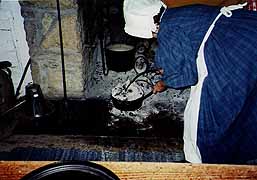
Dutch Treat
|
The tavern provided a beautiful demonstration of how cooking was
being changed in the 1830’s. It was open fire cooking. The demonstrator
said that oak was the wood of choice because it is dense, burns
slow and gives wonderful coals. She was in the middle of cooking
corn bread in a Dutch oven. The dough is put in a heavy prefab
iron pot with flat lid. Live coals are then heaped on and around
the pot. We got to see and smell the gorgeous result! I’d like
to try this method. Another type of “stove” was a large tin box
that was set on the floor in front of the open fire. It could
be used for bread or a roast since a spit went through the box
and a roast could be turned in the box and the juices collected
on the bottom and used to baste it. How logical to make the next
step and put the fire itself in a cast iron box. Mary Lincoln
had a new cast iron stove in the 1840’s in Springfield!
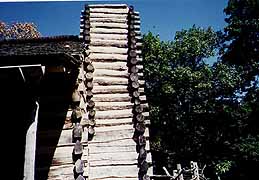
Log Chimney
|
Basically, Lincoln got to New Salem because of a flat boat. He
and two friends hired out to a man whose goods they took down
the Mississippi by flat boat and then returned to Illinois. He
showed a cool attitude when the flat boat got stuck on a bar,
the owner remembered and hired Lincoln a bit later to help in
his store in New Salem. |
The flat boat incident also spurred Lincoln to creation. He designed
a set of two expandable air tanks to go under a flat boat. Air
could be pumped from one to the other to maneuver a stuck boat
off a sand bar. There is a model of the device in the small Lincoln
museum in Springfield.
Deciding on a law career, Lincoln moved the twenty-two miles to
Springfield in 1837. It was then a town of 2500 people. In 1842
he married Mary Todd. He lived in Springfield until he moved to
Washington in 1861 as president.
SPRINGFIELD

(Model of original Lincoln house)
The four block area around the Lincoln home downtown have been
blocked off to traffic. There are board sidewalks and sawdust
covered streets. The houses in the area are all being prettified
and painted and each has a sign describing the owner and his/her
relation to the Lincolns. You really do get the feel of a neighborhood
without modern intrusions.
The Lincoln house is modest and quite close to the street. I remember
pictures I had seen and how the house seemed small, especially
with Abe Lincoln standing in front. In fact, it is a small house
for a successful lawyer and politician (more below) and began
smaller still. It had belonged to the minister who married Abraham
and Mary Todd. When the Lincolns bought it for $1500 it was a
one story house like the one next door, basically four rooms on
the ground floor with kitchen in the el and low attic rooms upstairs.
The Lincolns added a full height second floor. I think the proportions
seem odd because it is so near the street. Most other two story
houses of the time and place stand back thirty feet or so, there
is a scant ten feet to the Lincoln’s front door. They have a deep
fenced back yard that held a pump over the well (near the back
door) a wash house (that was later torn down), a vegetable garden,
an outhouse, and a barn. They always kept a horse and a cow and
probably chickens, too. Our image of Abe should include him bridling
his horse to ride the circuit and hitching up a wagon. Mary probably
milked the cow, planted and picked vegetables and collected eggs.
| There are five downstairs rooms. To the left as you enter is the
formal double parlor. Folding doors can divide it into a parlor
in the front and a study in the back. Sometimes Lincoln would
received gentleman in one section while Mary met the ladies in
the others. The furnishing are period, as close to the original
as possible, with historic drawings of the Lincoln house used
for reference. The guide noted that the recreated wallpaper was
accurate in pattern but not in color since the existing drawings
are black and white. The horsehair furniture did belong to the
Lincolns. The rooms are perhaps fifteen feet square, the furniture
is sparse. There are heavy curtains and good knickknacks on the
mantle. Apparently the boys were not allowed in those two rooms. |
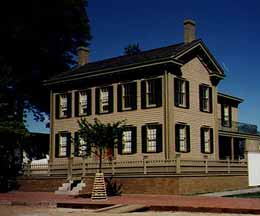
Lincoln House
|
To the right of the front door and stairwell is the large family
room. The carpet was a woven pattern with broad background strips
of green, red, white. It apparently could be ordered in strips
and then sewn together. The heavy curtains “pooled” on the floor
with extra fabric. The guide pointed out that this was for a nature
effect. The green curtains and then the pools. This also had the
effect of holding the curtains nearer the windows to retain heat.
The furniture (horsehair chairs and several rockers) was small
for Lincoln. The guide said he most often lolled on the floor
often without shoes. Or he might turn a rocker over and lean on
it for a backrest. There was a sewing kit, as Mary sewed many
of the family’s clothes.
The guide said the Lincoln boys were considered “hellions” by
some neighbors, indulged by their parents. They were all educated
at home. Robert then went off to a boarding school and later college.
Eddie died at three, Willie died in the White House, Tad died
in his late teens a few years after his father’s death.
|
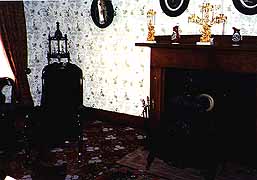
Parlor
|
Behind the family room was the dining room - Lincoln’s favorite
meal was a good steak, corn bread and coffee - and behind that
the small kitchen. Mary Lincoln made the kitchen smaller when
she remodeled since she preferred a large dining room. (“She was
always trying to civilize her husband,” said the guide.) The stove
was the latest cast iron model but seemed short to me, too much
bending.
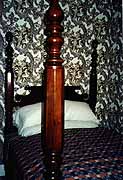
4 poster
|
Upstairs there were five bedrooms. A guest room, separate rooms
for Mary and Abraham as was customary at the time. Lincoln’s bedroom
over the front good parlor had a tiny desk where he wrote. Mary’s
room was over the study. She had a wooden ”close stool” rather
than a chamber pot. There was one bedroom for the boys since there
were never more than two in residence, and a back bedroom for
the hired girl. The furnishing are fairly plain, the rooms average. |
MARY LINCOLN
I came away from my tours with a new respect and affection for
Mary Todd, an educated and ambitious young woman who chose an
unlikely suitor, unacceptable by her family’s measure. She reveled
in an informal family life quite unlike that of her childhood
home, managed a home and four sons with one servant, coped when
her husband was away on the legal circuit for months at a time
and survived the deaths of three of her four sons (all before
adulthood) and the assassination of her husband. Far from the
snobbish social climber I expected, Mary Lincoln was a loved neighbor
who sewed her family’s clothes and cooked well. She married a
self-educated and homely man raised in poverty. Her faith in him
was rewarded. How important was she to his success?
| “I would rather marry a good man - a man of mind - with a hope
and bright prospects ahead for position - fame & power than to
marry all the houses of gold in the world.” -Mary Todd Lincoln
|
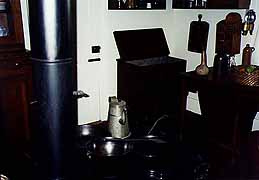
Mary's Kitchen
|
Why was Mary Lincoln so vilified? I had “known” she was a heavy
spender who loved clothes and drove the president into debt. She
was a manic depressive who apparently held seances in the White
House after her son died there. She was frivolous, vain, ambitious,
I’d heard. There were claims that she was a southern spy during
the Civil War.
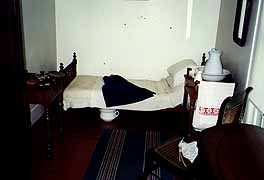
Amenities
|
Well, Mary Lincoln was a different type of first lady (any modern
parallels?) Highly educated - thirteen years of formal schooling
(a husband who had only one). She came from an affluent Kentucky
family, her sister was married to the son of the Illinois governor.
When she got to the White House, the grande dame side of Mary
Lincoln came out. She hostessed grand occasions, bought fine clothes,
added to the elegant surroundings. Look at the pictures of the
Lincolns during his presidency and you will see an elegant couple
in an elegant home. |
In spite of her loyalty to Lincoln and the North she was harshly
judged, mainly because her family was southern and slave owning.
Several brothers fought and died for the South. Mary’s agony during
the war must have been extreme, but an agony common to many families
split by the war.
ABRAHAM LINCOLN
| Then there is the image of Abe. Lanky, unkempt, awkward, absentminded,
disorganized. But...according to the guides he was an excellent
lawyer making far more income than most people. He speculated
in land in Iowa. As a politician he was elected and reelected
to the state legislature and successfully ran for president for
a new political party. |
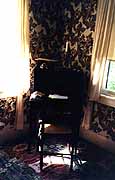
Small desk
Big man
|














